Artwork of Jean-Michel Basquiat artprints & posters
An essential painter and graffiti artist in the world of contemporary art, Jean-Michel Basquiat demonstrated the full extent of his talent with his energetic and colourful paintings, incorporating the codes of Afro-American culture and modern art. His collaborations with numerous other artists, and more particularly with Andy Warhol, elevated him to the rank of star of urban art and street painting, making him one of the first recognised black painters. Despite a short career marked by drugs, from New York to Los Angeles, via Paris, Tokyo and Düsseldorf, from the United States to the rest of the world, with his paintings displayed in the greatest museums such as MoMa, the Whitney Museum of American Art, and the Louis Vuitton Foundation, Jean Michel Basquiat definitively established himself as the painter and graffiti artist inseparable from the 80s.
Discover the drawings, graffiti and paintings of Jean-Michel Basquiat, with ‘Untitled (Crown of Thorns)’, ‘Untitled (For B.A.M.)’ and ‘Untitled (Head and Watermelon)’, paintings without names, as an echo to his past as a graffiti artist, ‘Jump King’, ‘King of the Zulus’, ’ Head with $ Me’, unmissable in pure Basquiat style, or even “Red Man”, “59 Cents (2 For a Dollar)” and “Quality Meats For The Public”, iconic and dramatic canvases by the artist. Treat yourself to a page from the history of contemporary art with a reproduction of Jean-Michel Basquiat, an emblematic figure of modern art in the second half of the 20th century, and discover his biography.
The privileged but troubled youth of Jean-Michel Basquiat
Born in 1960 in New York City, Jean-Michel Basquiat came from a family with a mother of Puerto Rican origin and a father from Haiti. A child prodigy, he grew up in the Brooklyn district and quickly developed an interest in the arts, his mother regularly encouraging him to visit the Museum of Modern Art in New York, the famous MoMA, where he could admire the museum's extensive collection and the works of the most prominent painters of the time.
In 1968, Jean-Michel Basquiat was hit by a car, which led him to discover numerous anatomy treatises during his convalescence, such as Gay's Anatomy, which would influence his future career as a contemporary artist and musician.
That same year, his parents divorced, his mother developed psychological problems, and Jean-Michel Basquiat followed his father, before leaving the country with his family in 1974, to go to Puerto Rico, then returning two years later to the United States and New York, at the age of 15. Educated in a privileged environment, he continued to train in art, and met Al Diaz, who would be one of the co-founders of the future graffiti collective ‘SAMO’.
Increasingly at odds with his father over their world views, Jean-Michel Basquiat ran away in 1976, then abandoned his studies completely, provoking his banishment from the family home and the beginning of his bohemian life.
Jean-Michel Basquiat's self-taught career begins
Now completely independent, Jean-Michel Basquiat, accompanied by his friends Al Diaz and Shannon Dawson, and later joined occasionally by Keith Haring, began to fully integrate the world of urban art, launching into graffiti in the Manhattan district of New York. Diaz and Basquiat thus created the SAMO collective, which made a real name for itself in the graffiti scene. At the end of SAMO, in 1979, Basquiat turned to other art forms, such as music with his rock group ‘Gray’, and cinema with his participation in the film ‘Downtown 81’, directed by Edo Bertoglio.
But his reputation only began to grow thanks to his participation in exhibitions such as ‘Times Square Show’ and ‘New York / New Wave’ in 1980, in which the young artist exhibited alongside other painters of the time such as Keith Haring, Robert Mapplethorpe and the famous Andy Warhol, without beginning collaborations with them. The success following the presentation of his works led Jean-Michel Basquiat to get closer to the Annina Nosei gallery, the collector Bruno Bischofberger, and the curator of the Metropolitan Museum of Art, Henry Geldzahler, who quickly became dealers and patrons of the artist. Annina Nosei even went so far as to allow him access to the basement of the gallery so that Basquiat could set up his studio there, and enabled him to hold his first solo exhibitions.
Recognition of the work of Jean-Michel Basquiat
Well established in the New York art world, Jean-Michel Basquiat's fame took an unprecedented leap in the United States in 1981, then in other countries, thanks to an article entirely dedicated to him in the contemporary art magazine ‘Artforum’. This recognition by his peers then opened up a number of collaborations for him to organise exhibitions in the United States, then in other countries, and this is how we find his works in particular at the exhibition of the group ‘Transavanguardia Italia / America’ in 1982 in Modena, alongside the drawings of Haring and other American contemporary artists, at the ‘Documenta’ in Kassel, Germany, in 1982, an exhibition in which he was the youngest painter on display, on a tour of Germany for the ‘Aspekte amerikanischer Kunst der Gegenwart’ in 1983, at the ‘Figuration Libre France/USA’ exhibition in 1984 in Paris, and at the French cultural centre in Addis Ababa in 1986, among many others.
With his success, and following a trip to Los Angeles, he quickly left the Annina Nosei gallery to work more closely with Bruno Bischofberger, who became his exclusive art dealer. He would also maintain a strong link with the city of Los Angeles, and more particularly with the Larry Gagosian Gallery, where he presented his collection of works on numerous occasions throughout his career. In 1984, he also travelled to Hawaii to find inspiration, and returned to New York after three months to exhibit at the famous MoMA, which he frequented as a child. In 1985, the cover of the New York Times Magazine dedicated to him presented Jean-Michel Basquiat as a key contemporary artist.
Jean-Michel Basquiat's productive relationship with Andy Warhol
Jean-Michel Basquiat's meeting with Andy Warhol, the unmistakable icon of the pop art movement in the United States, in 1980 was a decisive turning point for both painters. Although their paintings were displayed side by side in galleries and exhibitions, no collaboration was on the agenda at the time. It was not until 1982 that they really combined their talents. It was a pivotal year for Jean-Michel Basquiat. Encouraged by Warhol, of whom he was an immense admirer (he even painted him in his portrait ‘Portraits of Andy Warhol as a Banana’), he was urged to intensify his skills in anatomical drawing at the New York Academy of Art, and Warhol also took care to advise the prodigy in the management of his nascent fortune, foreseeing the immense success of the ever-growing collection of works.
The fruitful collaboration between Jean-Michel Basquiat and Andy Warhol enabled them to create over a hundred paintings and images together, demonstrating their powerful artistic understanding. Basquiat's brushstrokes met Warhol's daring pop, creating a unique artistic dialogue in the contemporary art landscape. Thus, in 1985, the public discovered the extent of their joint work at an exhibition at the Bruno Bischofberger Gallery in Zurich. However, the reception was colder than expected, far from the anticipated success, which affected their future collaborations.
Despite everything, Andy Warhol remained a true mentor to Basquiat, and in 1987, his death left an immense void in the artistic sphere and left a profound mark on Jean-Michel Basquiat. Marked by the death of his friend, the New York painter saw his artistic production diminish significantly, proof of Warhol's impact on Basquiat's artistic inspiration. The impact of drugs and stardom on the life of Jean-Michel Basquiat
Jean-Michel Basquiat's meteoric rise in the contemporary art world helped shape a new reality for the artist. From his career as a graffiti artist in the streets of New York to his status as a visionary painter, Basquiat's rapid rise to stardom forced him to adapt to circles far removed from his original environment. Navigating in a privileged environment where money is not lacking, Basquiat saw the gap widen between his beginnings as a graffiti artist and his current status as an artist with a recognised oeuvre.
This new environment and new wealth gave him easier access to the drugs he had already known about from his years in the SAMO collective. Although at first some of these substances seemed to fuel his creativity, enabling him to produce a steady stream of works and images that reinforced his fascination with the art world, they began to have harmful effects on his health. Jean-Michel Basquiat's addiction became more pronounced, as the precariousness of his beginnings and the effervescence of his stardom collided. Amidst these products, his productions continue to explore new depths, like a portrait of his rapidly changing life, and galleries in major cities continue to present his pieces in exhibition after exhibition, reflecting the contradictions of his existence. Each portrait, graffiti or canvas painted by Basquiat bears the scars of this turmoil, and presents him as a tormented artist who became a figurehead of a generation. Undermined by addictions and the devastating influence of drugs, his brilliant but short career left an indelible legacy for contemporary art.
The end of a brutal career and the legacy of Jean-Michel Basquiat
In 1988, after a period of limited activity following Warhol's death, Basquiat returned to work and presented his collection in collaborations with galleries and other museums, particularly in the United States and especially in New York, or in other countries such as France in Paris, or even Germany. It was after his last exhibitions in Paris, New York and Düsseldorf that Basquiat attempted to detoxify in Hawaii, before returning to New York a few weeks later, according to him, completely cured. However, drugs returned to his life, and he died of a heroin and cocaine overdose on 12 August 1988, leaving behind him a whole collection of individual works and pieces from his many collaborations.
Estimated at over 45 million dollars in the year of his death, Basquiat's work comprises a collection of around eight hundred paintings and over five thousand drawings. A large number of the paintings are unnamed (among many, we can cite ‘Untitled (Space Pork)’ (1977), ‘Untitled (Collage With Self-Portrait)’ 1978, ‘Untitled (Portrait of Steven Lack)’ 1981, ‘Untitled (Crown of Thorns)’ 1982, ‘Untitled (Crown)’ 1983, Untitled (Standing Man With Torch) 1983, or even Untitled (For B.A.M.) 1985 and Untitled (Apply to Forehead) 1987), iconic portraits such as ‘Portrait of a one A.K.A. King’ (1982) or “Self-Portrait with Suzanne” (1982), or famous paintings such as “Crown Hotel (Mona Lisa Black)” (1982), “Black Figure” (1982), “Red Savoy” (1983), or “King of the Zulus” (1984) and ’Head with $ Me’ (1988), Basquiat became one of the most influential street artists of his generation. He is still studied today in the major art schools and is represented in every country through exhibitions and retrospectives, such as at the Brooklyn Museum or the Whitney Museum of American Art in the United States, the Musée Cantini in Marseille, the Louis Vuitton Foundation and the Museum of Modern Art in Paris in France, the Kestnergesellschaft in Hanover and the Würth Museum in Künzelsau in Germany, among many other countries, Jean-Michel Basquiat is a key figure in contemporary art and street art, and his colourful and tortured works have influenced many artists.





























